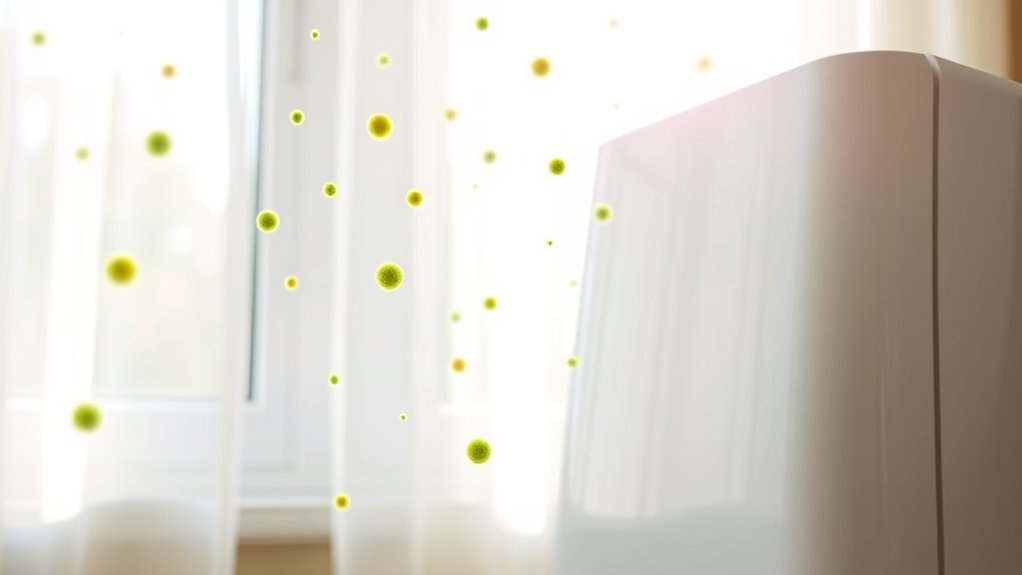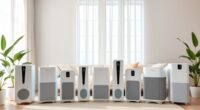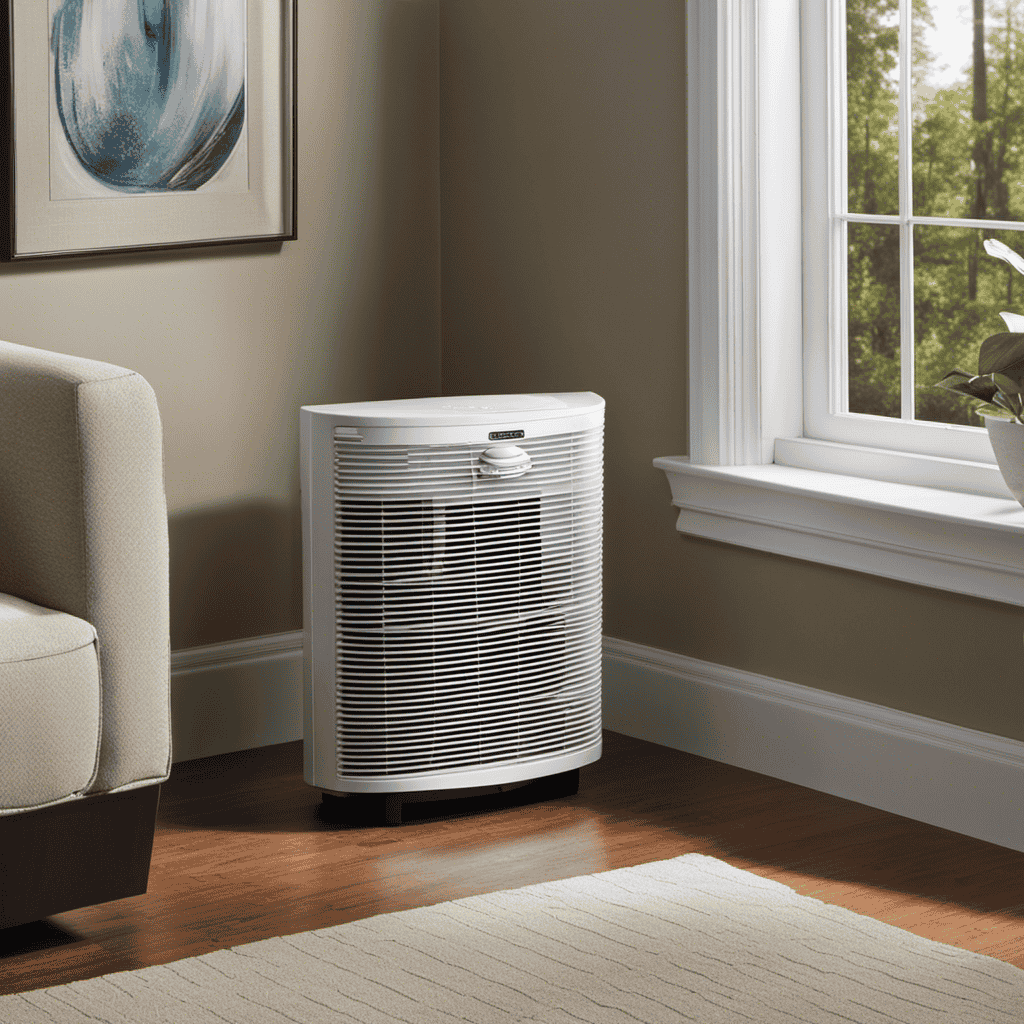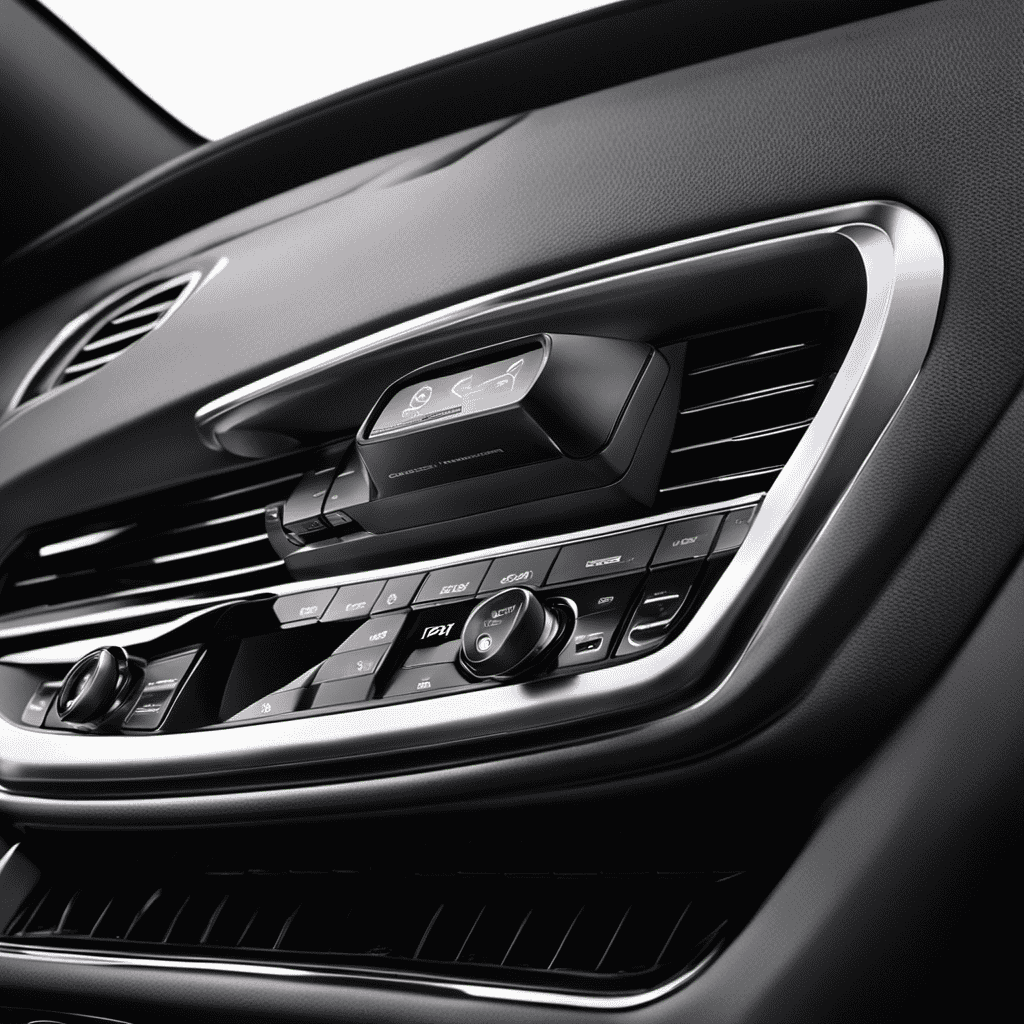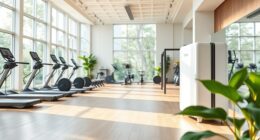During allergy season, air purifiers with HEPA filters can considerably reduce airborne pollen and other allergens, helping you breathe easier indoors. These devices trap tiny particles like pollen, dust, and pet dander, while activated carbon filters absorb odors and VOCs. Features like real-time air quality monitoring and automatic adjustments enhance effectiveness. Proper placement, maintenance, and combining with other allergy management tips can provide much-needed relief. If you keep exploring, you’ll discover how to maximize your air purifier’s benefits.
Key Takeaways
- Air purifiers with HEPA filters effectively trap pollen and airborne allergens, reducing indoor exposure during peak allergy seasons.
- Advanced sensors and automatic settings adjust filtration based on real-time air quality, enhancing allergy symptom relief.
- Combining HEPA and activated carbon filters removes pollen, odors, and chemical pollutants for comprehensive indoor air purification.
- Proper placement and regular maintenance ensure maximum effectiveness in capturing seasonal pollen and allergens.
- Using air purifiers alongside other allergy management strategies creates a healthier indoor environment during pollen seasons.
Understanding Seasonal Pollen Allergies and Their Impact
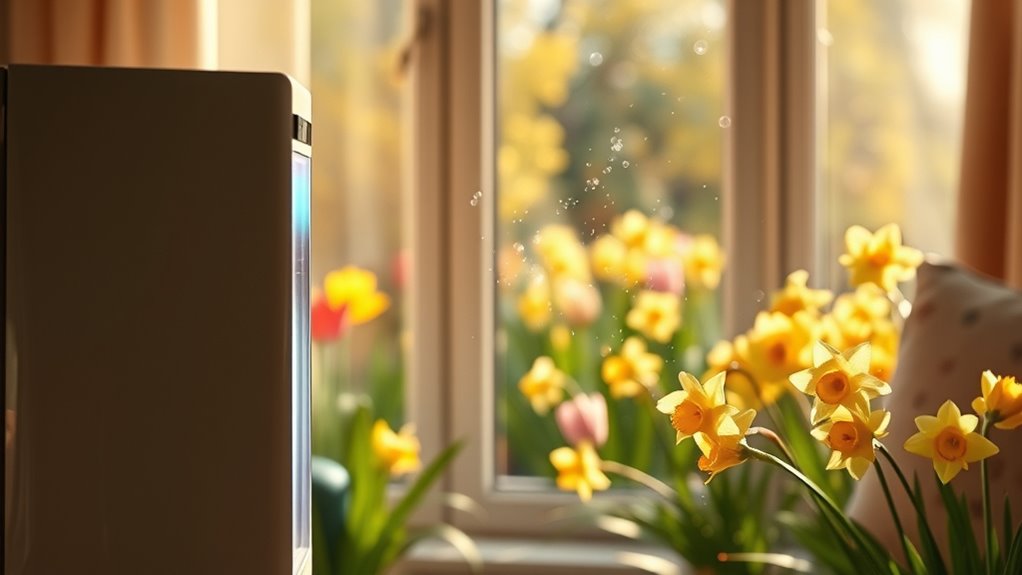
Seasonal pollen allergies can considerably affect your daily life, especially during certain times of the year. These allergies are triggered by seasonal triggers like pollen from trees, grasses, and weeds, which spike during specific pollen cycles. As these cycles progress, pollen counts rise, making outdoor activities uncomfortable or even impossible for allergy sufferers. Understanding these cycles helps you prepare and minimize exposure. During peak pollen seasons, you might experience sneezing, nasal congestion, and itchy eyes. Knowing when pollen levels are highest allows you to plan outdoor outings carefully or take preventive measures. Being aware of seasonal triggers and pollen cycles is key to managing your allergy symptoms and reducing their impact on your routine. Incorporating biodiversity in your local environment can also help reduce pollen levels over time by promoting diverse plantings that do not produce excessive pollen. Additionally, maintaining good indoor air quality with tools like air purifiers can significantly alleviate allergy symptoms during peak seasons. Modern air purification technologies, such as HEPA filters, are particularly effective at capturing pollen particles and other airborne allergens. Implementing these measures can improve indoor air quality and provide relief from allergy symptoms.
How Air Purifiers Work to Improve Indoor Air Quality
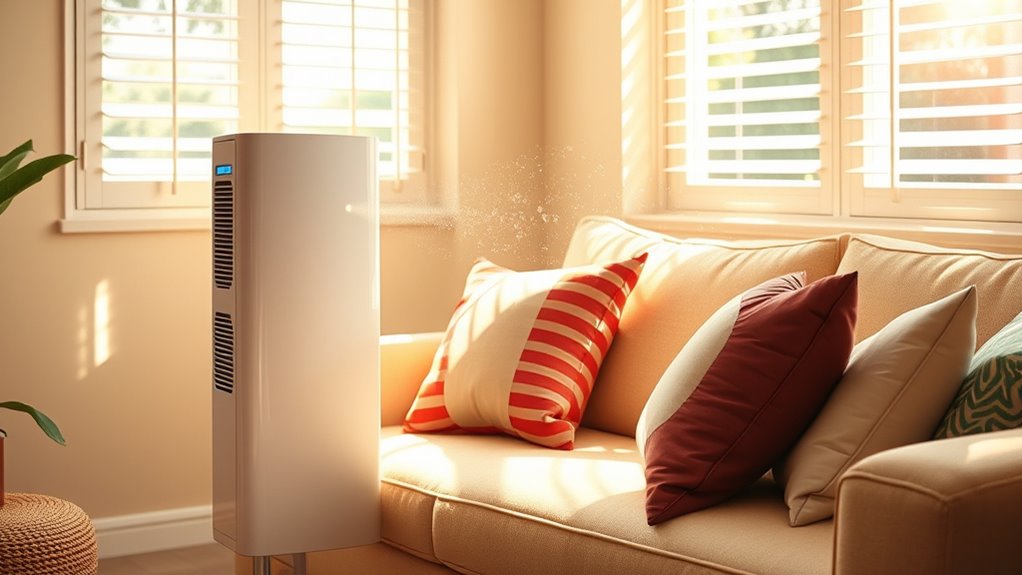
Air purifiers use advanced filtration technologies to clean the air you breathe. They trap allergens, dust, and pollutants, making your indoor environment healthier. Understanding how these filters work helps you choose the right device for allergy relief. Some models incorporate HEPA filters, which are highly effective at capturing tiny particles like pollen and pet dander, ensuring cleaner air for sensitive individuals. Additionally, knowing the types of filters available can help optimize your allergy management strategy. Modern air purifiers also utilize automation features to adjust filtration levels based on air quality, providing consistent relief. Many models also include carbon filters that help reduce odors and chemical pollutants for a more comprehensive purification process. Incorporating appropriate filter maintenance can further enhance their effectiveness and longevity.
Filtration Technologies Explained
Filtration technologies are the core of how air purifiers improve indoor air quality, capturing harmful particles before you breathe them in. HEPA filters trap pollen, dust, and pet dander efficiently, reducing airborne allergens. UV sterilization uses ultraviolet light to neutralize bacteria and viruses, adding an extra layer of protection. Activated carbon filters absorb odors, chemicals, and volatile organic compounds, making your environment fresher. These combined technologies work together to create cleaner, safer air. HEPA filters handle the bulk of particulate matter, while UV sterilization targets microorganisms, and activated carbon eliminates smells and gases. Understanding the mechanisms of filtration can help you choose an air purifier that effectively reduces allergy triggers and improves your indoor air quality during pollen season. Additionally, understanding AI security measures can help ensure that smart air purifiers and other connected devices remain protected from cyber threats. Incorporating air quality sensors into your system allows for real-time monitoring and adjustment of filtration levels to optimize health benefits, and innovations in sound healing science have shown promise in enhancing overall well-being through subtle vibrational therapy.
Removing Allergens Effectively
Understanding how air purifiers remove allergens helps you choose the right device for your needs. Air purifiers target airborne particles like pollen, pet dander, and dust mites that trigger allergy symptoms. HEPA filters are especially effective, trapping particles as small as 0.3 microns, including pollen and other allergens. Activated carbon filters absorb odors and chemical pollutants, further improving air quality. To enhance allergen removal, avoid relying solely on indoor plants, which can sometimes harbor mold or dust that worsen allergies. Instead, focus on using a high-quality air purifier with proper filtration. Regular maintenance, including changing filters, guarantees peak performance. Incorporating filter replacement indicators can help you stay on top of maintenance needs. Choosing a device with advanced filtration technology can provide even more comprehensive allergen removal. By actively removing airborne particles, your air purifier creates a cleaner indoor environment, providing relief during allergy season.
Key Features to Look for in an Air Purifier for Allergies
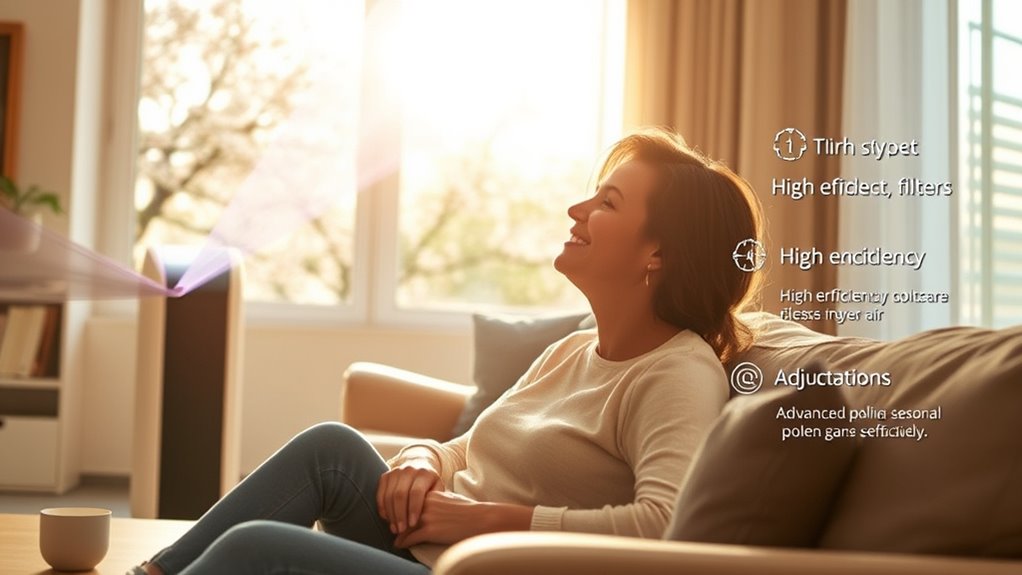
When choosing an air purifier for allergies, it’s essential to focus on key features that guarantee effective removal of allergens from your indoor environment. Look for units equipped with advanced air quality sensors, which monitor pollutant levels in real-time and automatically adjust fan speed to optimize air cleaning. This ensures you’re always breathing cleaner air without manual intervention. Additionally, prioritize allergen filters designed specifically for capturing pollen, dust mites, and pet dander. A high-quality allergen filter, such as a true HEPA filter, combined with sensors, provides targeted removal of airborne allergens. Incorporating air filtration technology about local pollen counts and allergy trends can further enhance your choice of an air purifier. Understanding seasonal allergy patterns and how they vary regionally can help you select the most effective device. Being aware of air quality fluctuations during different times of the year can aid in timing your use of air purifiers for maximum relief. These features work together to improve indoor air quality, reduce allergy symptoms, and create a more comfortable living space during peak allergy seasons.
The Role of HEPA Filters in Capturing Pollen and Allergens
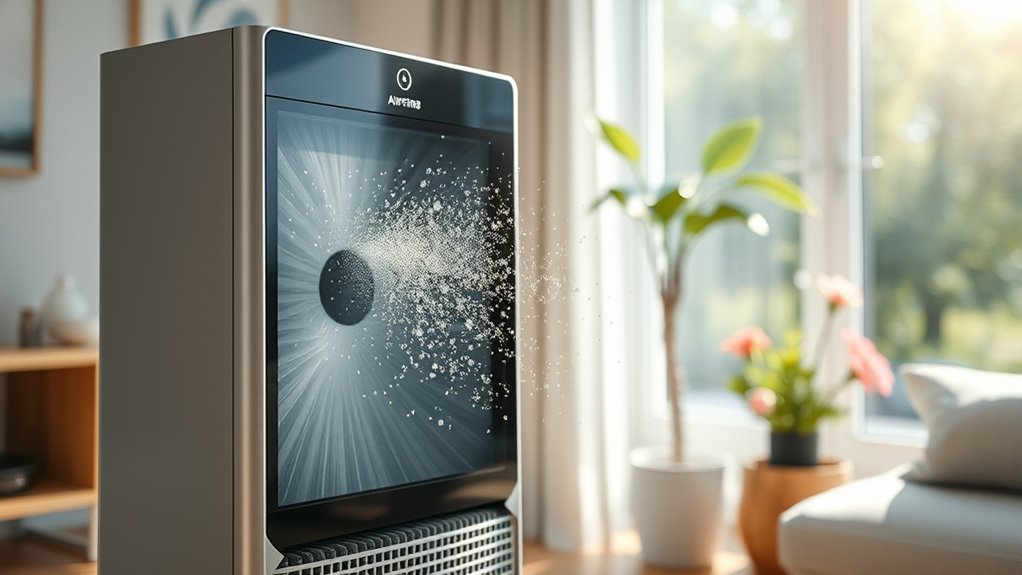
HEPA filters play a crucial role in capturing airborne pollen and allergens, making them indispensable for allergy sufferers. Their high HEPA efficiency ensures that tiny particles, including pollen grains and pet dander, are effectively trapped. These filters are designed with densely packed fibers that create a maze, forcing allergens to collide and stick. As a result, HEPA filters excel at allergen trapping, substantially reducing indoor pollen levels. When you use an air purifier with a HEPA filter, you’re actively removing these particles from the air you breathe, which can lead to noticeable relief during allergy season. Proper maintenance, like regular filter replacements, maintains ideal allergen trapping and ensures your air purifier continues to perform at its best. Regular filter replacement and air quality control are essential for maintaining peak filter performance and maximizing allergen removal. Additionally, selecting an air purifier with an appropriate filter efficiency rating can further enhance allergen removal effectiveness.
Additional Technologies That Enhance Air Purification
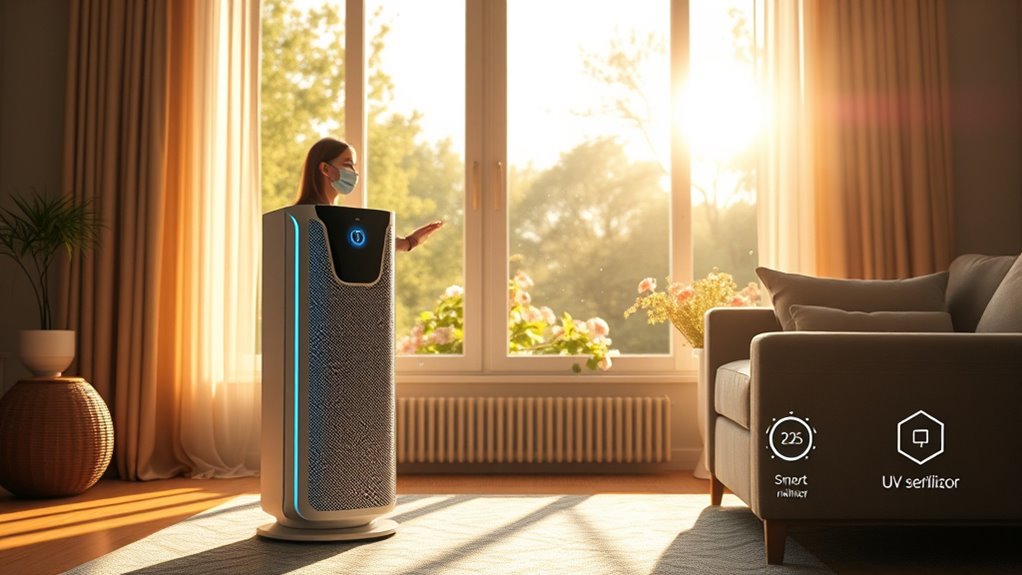
In addition to HEPA filters, several advanced technologies can further improve air purification and provide relief from seasonal allergies. UV sterilization uses ultraviolet light to destroy bacteria, viruses, and mold spores, reducing airborne pathogens that can worsen allergy symptoms. This technology is especially helpful in maintaining a cleaner indoor environment. Activated carbon filters also play a vital role by absorbing odors, chemical pollutants, and volatile organic compounds (VOCs) that may be present alongside pollen and allergens. Combining UV sterilization with activated carbon enhances your air purifier’s ability to create a healthier, fresher indoor space. Additionally, integrating AI-powered sensors can optimize air purification by detecting pollutant levels in real-time and adjusting filtration accordingly. These air quality monitoring technologies work together to target a wider range of airborne particles, ensuring you breathe cleaner air and experience greater relief during allergy season. Incorporating air filtration efficiency principles can further maximize the effectiveness of your air purifier and improve overall indoor air quality. For example, selecting a unit with high filter replacement indicators ensures consistent performance and maintenance. Moreover, selecting devices with advanced filtration features can help eliminate a broader spectrum of allergens and pollutants, providing an even more comprehensive solution.
Best Practices for Using Air Purifiers During Allergy Season
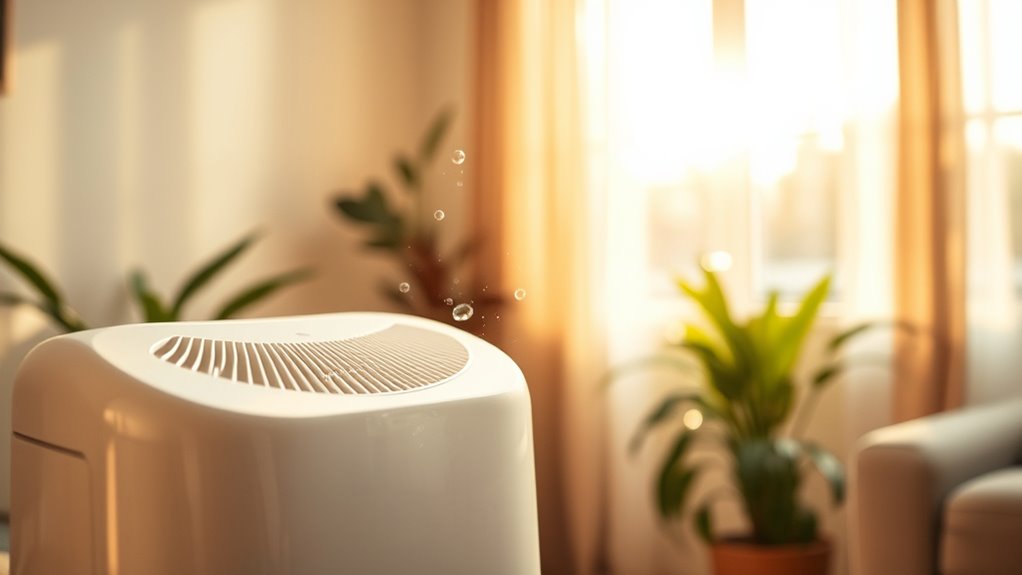
To get the most out of your air purifier during allergy season, you need to choose the right filters, place it in the best spot, and keep up with regular maintenance. Proper filter selection guarantees you’re capturing as many allergens as possible, while strategic placement maximizes its effectiveness. Staying consistent with maintenance routines keeps your purifier running efficiently and your air clean. Additionally, embracing a creative practice can help develop air purifier maintenance dos and don’ts and problem-solving skills that may assist in troubleshooting or optimizing your air purifier setup. Considering tuning techniques from automotive upgrades can inspire innovative approaches to maintaining your device’s performance and longevity.
Proper Filter Selection
Choosing the right filter is vital for maximizing your air purifier’s effectiveness during allergy season. Look for models equipped with HEPA filters, as they capture 99.97% of airborne particles like pollen, dust, and pet dander. These filters are essential for reducing allergy triggers. Additionally, consider an activated carbon filter, which absorbs odors and airborne chemicals that can worsen allergy symptoms. Combining HEPA and activated carbon filters provides thorough filtration, targeting both allergens and unpleasant smells. Make certain your air purifier uses high-quality filters and replace them regularly according to the manufacturer’s instructions. Proper filter selection guarantees your purifier operates at peak efficiency, helping you breathe easier and enjoy relief during allergy season.
Optimal Placement Strategies
Proper filter selection is just the first step; where you place your air purifier considerably impacts its efficiency during allergy season. To maximize benefits, focus on ideal air purifier placement by positioning it in central locations away from walls or furniture that block airflow. Keep it elevated, such as on a table or shelf, to improve indoor airflow enhancement and guarantee even distribution of purified air. Avoid corners or enclosed spaces where airflow is restricted, reducing effectiveness. Instead, place the purifier near common allergy sources, like bedrooms or living rooms, where you spend the most time. Regularly adjust the placement based on room size and airflow patterns, ensuring that purified air circulates freely and reaches all areas, providing the best relief during allergy season.
Regular Maintenance Routines
Regular maintenance is essential to guarantee your air purifier works effectively during allergy season. Consistently perform air purifier maintenance by cleaning or replacing filters as recommended by the manufacturer. This ensures the device continues to trap airborne allergens like pollen and dust effectively. Regularly check allergen tracking reports or monitor air quality indicators to assess how well your purifier is performing. Keeping filters clean prevents buildup that can reduce airflow and filtration efficiency. Additionally, ensure vents and intake areas are free of dust or debris. By maintaining your air purifier properly, you’ll maximize its ability to reduce allergens and provide relief during peak pollen times. Staying proactive with maintenance routines helps you enjoy cleaner indoor air and better allergy symptom management.
Tips for Maintaining and Selecting the Right Device
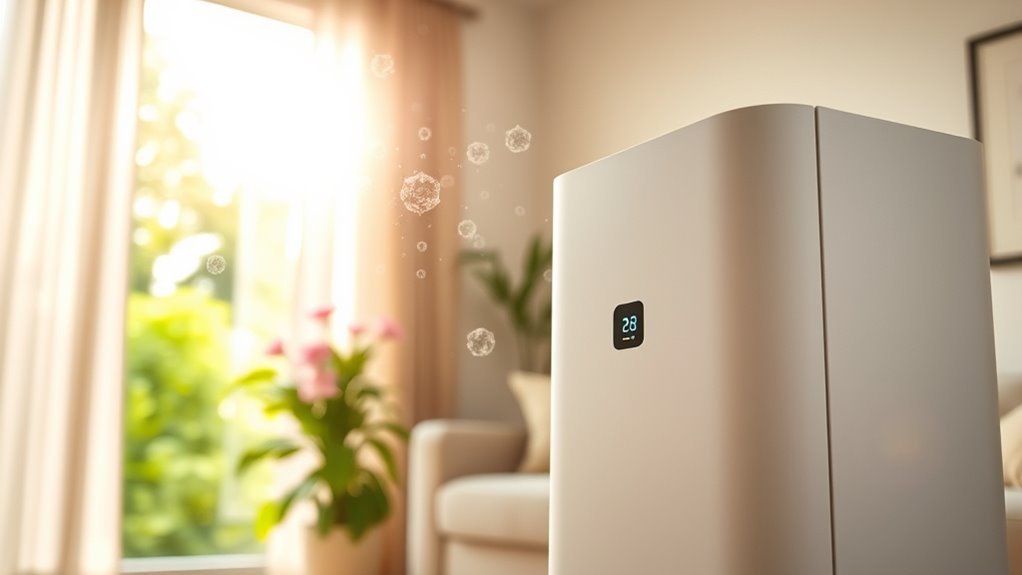
To guarantee your air purifier effectively reduces allergens, you need to select the right device and keep it well-maintained. Start by considering smart home integration, which allows you to control and monitor your purifier remotely, ensuring consistent operation. Look for models with adjustable noise levels, so you can run the device comfortably without disruption, especially during sleep. Choose an air purifier with a suitable CADR (Clean Air Delivery Rate) for your room size to maximize efficiency. Check the filter type—HEPA filters are best for allergens. Regularly replace filters as recommended. Finally, select a device with user-friendly controls and reliable performance, ensuring it fits seamlessly into your daily routine while providing continuous relief during allergy season.
Complementary Strategies for Managing Allergy Symptoms
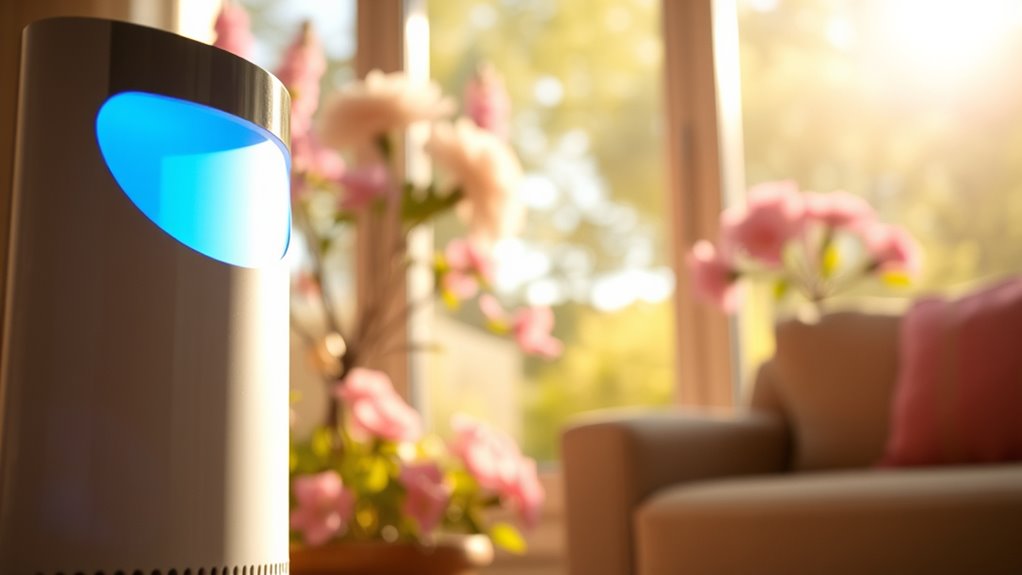
While choosing and maintaining an effective air purifier plays a vital role in reducing allergens indoors, managing allergy symptoms often requires additional strategies. Incorporate indoor plant benefits, such as air filtering and humidity regulation, to naturally improve air quality. Using allergen-proof bedding can also reduce exposure to dust mites and pollen while you sleep. Consider creating a calming environment with these elements:
| Indoor Plant Benefits | Allergen-Proof Bedding Benefits |
|---|---|
| Filter airborne particles | Blocks dust mites and pollen |
| Boost humidity | Reduces allergen buildup |
| Improve air circulation | Enhances sleep quality |
Combining these strategies helps create an allergy-friendly home, providing you relief beyond just air purification.
Frequently Asked Questions
Do Air Purifiers Eliminate All Types of Pollen?
You might wonder if air purifiers eliminate all pollen types. While they excel at pollen filtration and allergen removal, no device can remove every pollen particle completely. High-efficiency models with HEPA filters considerably reduce pollen levels in your space, providing relief. However, some tiny particles might still linger. Using an air purifier alongside other measures helps create a cleaner, allergen-reduced environment, easing allergy symptoms effectively.
How Often Should I Replace Filters in My Air Purifier?
Did you know that a dirty filter can reduce your air purifier’s efficiency by up to 50%? To keep it working effectively, follow the manufacturer’s maintenance schedule for filter replacement—usually every 3 to 6 months. Regular filter replacement ensures cleaner air and better allergy relief. Keep an eye on your device’s indicators and replace filters promptly to maintain peak performance and health benefits.
Can Air Purifiers Help With Outdoor Pollen Exposure?
Yes, air purifiers can help with outdoor pollen exposure by improving indoor air quality and providing effective pollen filtration. When you bring pollen indoors, an air purifier captures these particles, reducing your allergy symptoms. Choose a model with high-efficiency filters like HEPA to trap tiny pollen grains. Using it regularly guarantees cleaner air inside, so you breathe easier even during high pollen seasons.
Are There Specific Brands Recommended for Allergy Relief?
When choosing an air purifier for allergy relief, you want reliable brands that focus on allergen removal and HEPA filters. Look for models like Dyson, Blueair, or Honeywell, which are known for their high-quality filtration. These brands actively filter out pollen, dust, and other allergens, helping you breathe easier. By selecting a trusted brand with proven allergen removal, you create a healthier indoor environment and find relief during allergy season.
How Loud Are Air Purifiers During Operation?
When you ask about noise levels, most air purifiers operate quietly, with some models emitting just a gentle hum or soft operational sounds. Higher-capacity units might be slightly louder but still remain unobtrusive in everyday use. You can find devices with adjustable fan speeds, allowing you to balance filtration efficiency and noise levels. Overall, many air purifiers are designed to blend seamlessly into your space without causing significant disturbance during operation.
Conclusion
By choosing the right air purifier and following these tips, you can breathe easier during allergy season. But remember, not all devices are created equal—some might surprise you with features you didn’t expect. Are you ready to discover which purifier will truly make a difference in your home? Stay vigilant, and don’t settle for less. Your allergy relief could be just a filter change away—are you prepared to find out?
